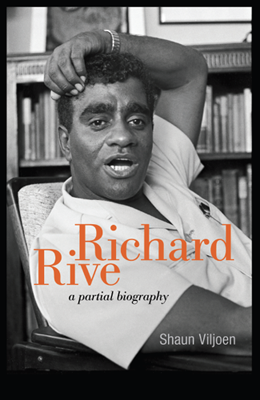Launch of Richard Rive: A Partial Biography by Shaun Viljoen, 10 September 2013, District Six Museum. Shaun Viljoen in discussion with Bonita Bennet and Bill Nasson. Featuring a dramatised extract from Rive’s Buckingham Palace, District Six by actor/director Basil Appollis.
DAVID VERSTEEG
The evening started exactly as it would end: full of stories. Long before the event got going there were the old and the young, the local and further from home, catching up, winding down. Stories exchanged hands between the far and the wide, new locals and old locals, both colleagues, childhood friends and students. The occasion was intimate: many of those present had known the writer before his death, were taught by him or even taught alongside of him.
Thus the launch of the book, for which Viljoen was joined by Bill Nasson and Bonita Bennet, echoed the daunting task of its writing: how to portray a man known to many, a person etched into a collective memory? Indeed, how to account for the printing of one story over so many others that existed, and still do exist? We carry the past with us, even as it is carried by others, even as it carries itself. Behind the stage stood a bench, a visible remainder and reminder of a past of dehumanisation: “slegs vir blankes”. In front of the stage was a host of familiar faces, pieces of the very same story recently put down in paper. Framed against the past, Shaun Viljoen was about to justify himself with verve.
We learn that the book is “tentative about the idea of biography. Can a book really tell of a life?”After WWI, authors like Virginia Woolf and others have explored the idea that “biography is an objective account of men, by men, of their public lives.” The book seeks to pursue the undisclosed connections between the private and the public, to find a way to fill in the gaps. But the author has a clear sense that the biography isn’t complete and shouldn’t be approached as such. The biography is partial, starting from “a position of ambivalence about Rive the man.” Viljoen said that Rive “always seemed too big, too large to contain.” Instead, we are invited to take up the book as a weaving of stories, interpreted and mediated by the author, in an attempt to make sense of a previous life.
Throughout the event the audience was alert and trying to make sense of the project presented to them, and many questions betrayed curiosity: how much of Rive’s private life will we find? And how much of what we read is the author's own voice coming through? Viljoen argues for a sustained personal vantage point, a position of personal interest. On the one hand, there was Rive the activist and essayist, the writer, teacher and mentor while on the other hand lived the private man, figuring how to navigate his homosexuality and loneliness. The position he takes seems healthy. There is recognition of his personal stance, while simultaneously acknowledging that there is no other way to tell a story: the embrace of both positions is the heart of the attitude towards the biography.
The conversation returns to the communal nature of knowledge of the man, and now, the subject of a book. Viljoen portrays a sense of wonder at the multiplicity of the number of people connected to Rive in one way or another, and the nature of their memories: “When I talk to people about Rive I don’t get a comment about what a nice man he was, or how he was larger than life: I get another story, another witticism, an anecdote.” And so the event went: one story after the next, intimations from Professor Bill Nasson, an excerpt from Rive’s Buckingham Palace, District Six, masterfully performed by Basil Appollis. Then, a memory from the audience of Rive the teacher, and another memory: Rive the bully.
Shaun Viljoen has done brave thing, to write a book on Rive as a peer among peers, as an author amid those who write, writing about the writer everybody knew, and many knew personally. But Viljoen claims his position and stands his ground with humility and determination. At the end of the evening, he gets up to remind of us what, among all other interpretations, the book is. He thanks Richard Rive, saying “I am not sure how much of this he would like, and how much would be venomously, vehemently attacked. I have to remind myself this is about Richard, yes: but it’s my story about him.”
It was an intimate evening, filled with a sense of history that reached into the moment, filled with the presence of multiple connections. The various parts streamed gently into each other, leaving us all with a wholesome feeling, an appreciation of honest work. Shaun Viljoen has sedulously crafted a partial response to a previous life and presented it to us with style and consideration.
 SLiPStellenbosch Literary Project
SLiPStellenbosch Literary Project 